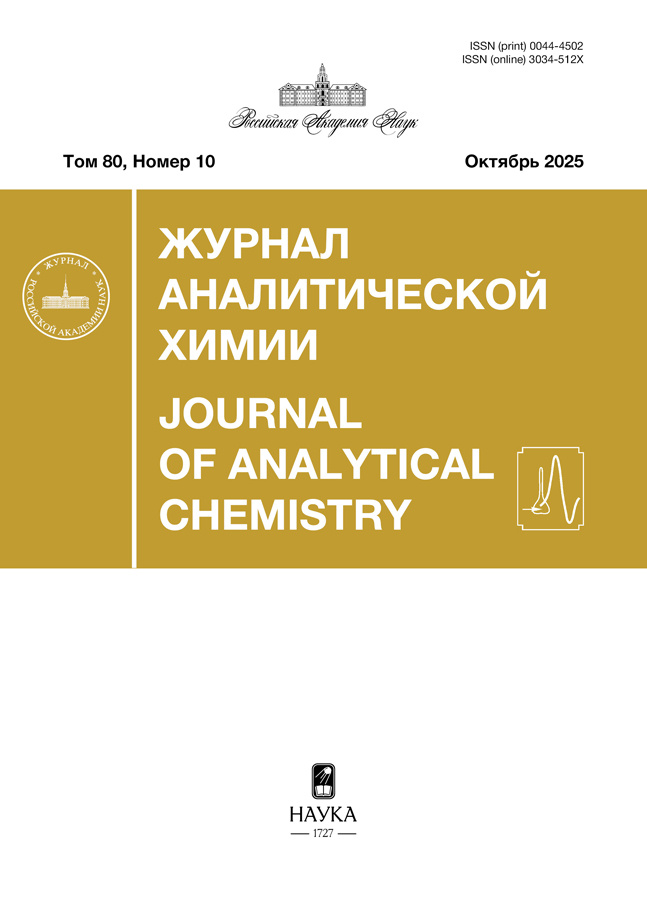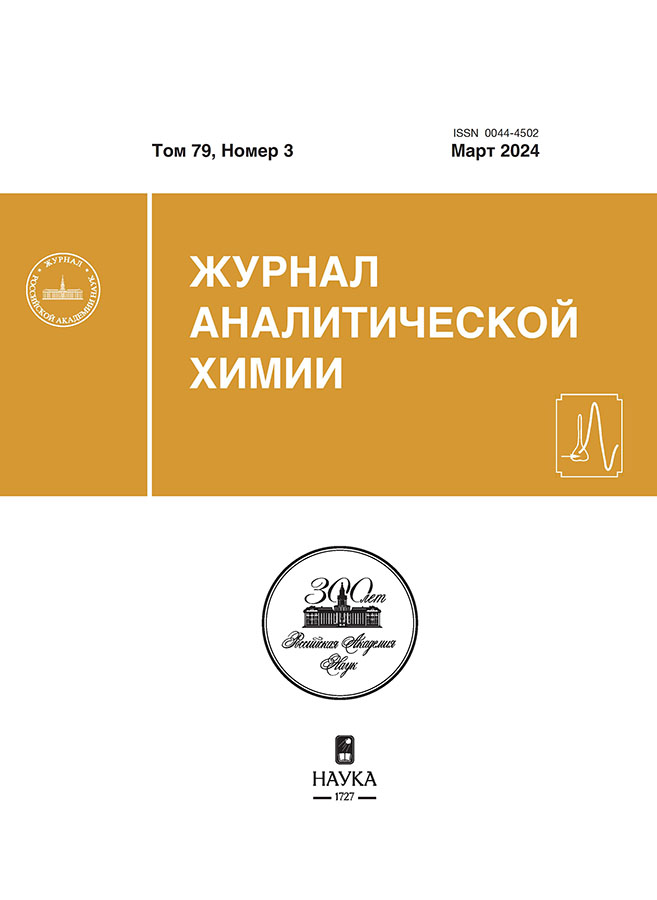Определение Cr и Ni в морской воде методом электротермической атомно-абсорбционной спектрометрии высокого разрешения с источником сплошного спектра
- Авторы: Бурылин М.Ю.1, Копейко Е.С.1, Костюченко Е.С.1
-
Учреждения:
- Кубанский государственный университет
- Выпуск: Том 79, № 3 (2024)
- Страницы: 263-271
- Раздел: ОРИГИНАЛЬНЫЕ СТАТЬИ
- Статья получена: 31.01.2025
- URL: https://rjonco.com/0044-4502/article/view/650242
- DOI: https://doi.org/10.31857/S0044450224030064
- EDN: https://elibrary.ru/vqevan
- ID: 650242
Цитировать
Полный текст
Аннотация
Разработаны условия определения Ni и Cr в морской воде методом электротермической атомно-абсорбционной спектрометрии высокого разрешения с источником сплошного спектра (ВР-ИСС ЭТААС). Азотная кислота использована в качестве химического модификатора. Проведено сравнение аналитических возможностей данного варианта метода с вариантом электротермической атомно-абсорбционной спектрометрии низкого разрешения с линейчатыми источниками излучения (НР-СИС ЭТААС) и дейтериевой коррекцией фона. Градуировочная зависимость построена по стандартным растворам аналитов. Методики определения Cr и Ni апробированы на образцах воды Черного моря по методу введено−найдено. С использованием варианта ВР-ИСС ЭТААС достигнуты пределы обнаружения (мкг/л): 0.12 для Cr и 0.09 для Ni (дозировка 80 мкл). Для метода НР-СИС ЭТААС эти показатели хуже: 0.6 мкг/л (Cr) и 1 мкг/л (Ni) при дозируемом объеме пробы морской воды 10 мкл. Показана возможность применения метода ЭТААС для прямого определения содержаний Cr и Ni в морской воде на уровне на два порядка ниже предельно допустимых концентраций.
Ключевые слова
Полный текст
Об авторах
М. Ю. Бурылин
Кубанский государственный университет
Email: kopeikoelena@yandex.ru
Россия, ул. Ставропольская, 149, Краснодар, 350040
Е. С. Копейко
Кубанский государственный университет
Автор, ответственный за переписку.
Email: kopeikoelena@yandex.ru
Россия, ул. Ставропольская, 149, Краснодар, 350040
Е. С. Костюченко
Кубанский государственный университет
Email: kopeikoelena@yandex.ru
Россия, ул. Ставропольская, 149, Краснодар, 350040
Список литературы
- Amais R., Ribeiro. J., Segatelli M., Yoshida I., Luccas P., Tarley C. Assessment of nanocomposite alumina supported on multi-wall carbon nanotubes as sorbent for on-line nickel preconcentration in water samples // Sep. Purif. Technol. 2007. V. 58. № . 1. P. 122. https://doi.org/10.1016/j.seppur.2007.07.024
- Padarauskas A.V., Kazlauskiene L.G. Ion-pair chromatographic determination of chromium (VI) // Talanta. 1993. V. 40. № . 6. P. 827.https://doi.org/10.1016/0039-9140(93)80037-r
- Pretty J.R., Blubaugh E.A., Caruso J.A., Davidson T.M. Determination of chromium (VI) and vanadium (V) using an online anodic stripping voltammetry flow cell with detection by inductively coupled plasma mass spectrometry // Anal. Chem. 1994. V. 66. № . 9. P. 1540. https://doi.org/10.1021/ac00081a029
- Van Landuyt J., Kundu K., Van Haelst S., Neyts M., Parmentier K., De Rijcke M., Boon N. 80 years later: Marine sediments still influenced by an old war ship // Front. Mar. Sci. 2022. P. 1973. https://doi.org/10.3389/fmars.2022.1017136
- Özzeybek G., Alacakoç B., Kocabaş M.Y., Bakırdere E.G., Chormey D.S., Bakırdere S. Trace determination of nickel in water samples by slotted quartz tube-flame atomic absorption spectrometry after dispersive assisted simultaneous complexation and extraction strategy // Environ. Monit. Assess. 2018. V. 190. № . 9. P. 1. https://doi.org/10.1007/s10661-018-6884-z
- Tuzen M., Saygi K.O., Soylak M. Solid phase extraction of heavy metal ions in environmental samples on multiwalled carbon nanotubes // J. Hazard. Mater. 2008. V. 152. № . 2. P. 632. https://doi.org/10.1016/j.jhazmat.2007.07.026
- Otero-Romaní J., Moreda-Piñeiro A., Bermejo-Barrera P., Martin-Esteban A. Synthesis, characterization and evaluation of ionic-imprinted polymers for solid-phase extraction of nickel from seawater // Anal. Chim. Acta. 2008. V. 630. № . 1. P. 1. https://doi.org/10.1016/j.aca.2008.09.049
- López-García I., Briceño M., Vicente-Martínez Y., Hernández-Córdoba M. Ultrasound-assisted dispersive liquid–liquid microextraction for the speciation of traces of chromium using electrothermal atomic absorption spectrometry // Talanta. 2013. V. 115. P. 166. https://doi.org/10.1016/j.talanta.2013.04.052
- Baysal A., Akman S. Assessment of chromium and nickel levels in surface sea waters and sediments from industrial marine area in Tuzla Aydinli Bay, Istanbul Turkey // Mar. Pollut. Bull. 2018. V. 130. P. 293. https://doi.org/10.1016/j.marpolbul.2018.03.033
- Sall M.L., Diaw A.K.D., Gningue-Sall D., Efremova Aaron S., Aaron J.-J. Toxic heavy metals: impact on the environment and human health, and treatment with conducting organic polymers, A review // Environ. Sci. Pollut. Res. 2020. V. 27. № . 24. P. 29927. https://doi.org/10.1007/s11356-020-09354-3
- Otero-Romaní J., Moreda-Piñeiro A., Bermejo-Barrera P., Martin-Esteban A. Inductively coupled plasma–optical emission spectrometry/mass spectrometry for the determination of Cu, Ni, Pb and Zn in seawater after ionic imprinted polymer based solid phase extraction // Talanta. 2009. V. 79. № . 3. P. 723. https://doi.org/10.1016/j.talanta.2009.04.066
- Huber C., Klimant I., Krause C., Werner T., Mayr T., Wolfbeis O.S. Optical sensor for seawater salinity // Fresenius J. Anal. Chem. 2000. V. 368. P. 196. https://doi.org/10.1007/s002160000493
- Пупышев А.А. Атомно-абсорбционный спектральный анализ. М.: Техносфера, 2009. С. 617.
- Соболев Н.А., Иванченко Н.Л., Кожевников А.Ю. Прямое определение свинца в морской воде методом атомно-абсорбционной спектроскопии высокого разрешения с использованием смешанного модификатора нитрат бария–фтороводородная кислота // Журн. аналит. химии. 2019. T. 74. № 5. С. 350. doi: 10.1134/S0044450219020129 (Sobolev N.A., Ivanchenko N.L., Kozhevnikov A.Y. Direct determination of lead in sea water by high-resolution atomic absorption spectroscopy using a mixed modifier barium nitrate–hydrofluoric acid // J. Anal. Chem. 2019. V. 74. № . 5. P. 444).https://doi.org/10.1134/s1061934819020126
- Acar O., Türker A.R., Kılıç Z. Direct determination of bismuth, indium and lead in sea water by Zeeman ETAAS using molybdenum containing chemical modifiers // Talanta. 1999. V. 49. № . 1. P. 135. https://doi.org/10.1016/s0039-9140(98)00358-0
- Acar O. Determination of cadmium, copper and lead in soils, sediments and sea water samples by ETAAS using a Sc+ Pd+ NH4NO3 chemical modifier // Talanta. 2005. V. 65. № . 3. P. 672. https://doi.org/10.1016/j.talanta.2004.07.035
- Cabon J.Y., Le Bihan A. The determination of Cr, Cu and Mn in seawater with transversely heated graphite furnace atomic absorption spectrometry // Spectrochim. Acta B. 1995. V. 50. № . 13. P. 1703. https://doi.org/10.1134/s106193481902012618.
- Cabon J.Y., Giamarchi P., Le Bihan A. Determination of iron in seawater by electrothermal atomic absorption spectrometry and atomic fluorescence spectrometry: A comparative study // Anal. Chim. Acta. 2010. V. 664. № . 2. P. 114. https://doi.org/10.1016/j.aca.2010.02.014
- Bermejo-Barrera P., Moreda-Pineiro J., Moreda-Pineiro A., Bermejo-Barrera A. Direct electrothermal atomic absorption spectrometry determination of nickel in sea water using multiple hot injection and Zeeman correction // Talanta. 1998. V. 45. № . 5. P. 807. https://doi.org/10.1016/s0039-9140(97)00159-8
- Dadfarnia S., Shakerian F., Shabani A.M.H. Suspended nanoparticles in surfactant media as a microextraction technique for simultaneous separation and preconcentration of cobalt, nickel and copper ions for electrothermal atomic absorption spectrometry determination // Talanta. 2013. V. 106. P. 150. https://doi.org/10.1016/0584-8547(88)80071-5
- De Loos-Vollebregt M.T.C., De Galan L. Furnace design in electrothermal atomization-atomic absorption spectrometry // Spectrochim. Acta B. 1988. V. 43. № . 4–5. P. 439. https://doi.org/10.1016/0584-8547(88)80071-5
- González-Álvarez R.J., Bellido-Milla D., Pinto J.J., Moreno C. A handling-free methodology for rapid determination of Cu species in seawater based on direct solid micro-samplers analysis by high-resolution continuum source graphite furnace atomic absorption spectrometry // Talanta. 2020. V. 206. Article 120249.https://doi.org/10.1016/j.talanta.2019.120249
- Burylin M.Y., Kopeyko E.S., Bauer V.A. Determination of Cu and Mn in seawater by high-resolution continuum source graphite furnace atomic absorption spectrometry // Anal. Lett. 2022. V. 55. № . 10. P. 1663. https://doi.org/10.1080/00032719.2021.2020806
- Salomon S., Giamarchi P., Le Bihan A., Becker-Rob H., Heitmann U. Improvements in the determination of nanomolar concentrations of aluminium in seawater by electrothermal atomic absorption spectrometry // Spectrochim. Acta B. 2000. V. 55. № . 8. P. 1337.https://doi.org/10.1016/s0584-8547(00)00240-8
- Krawczyk-Coda M. Halloysite nanotubes as a solid sorbent in ultrasound-assisted dispersive micro solid-phase extraction for the determination of bismuth in water samples using high-resolution continuum source graphite-furnace atomic absorption spectrometry // Spectrochim. Acta B. 2017. V. 129. P. 21. https://doi.org/10.1016/j.sab.2017.01.003
- Krawczyk M., Jeszka-Skowron M., Matusiewicz H. Sequential multi-element determination of iron and zinc in water samples by high-resolution continuum source graphite furnace atomic absorption spectrometry after column solid-phase extraction onto multiwalled carbon nanotubes // Microchem. J. 2014. V. 117. P. 138. https://doi.org/10.1016/j.microc.2014.06.023
- Krawczyk M., Jeszka-Skowron M. Multiwalled carbon nanotubes as solid sorbent in dispersive micro solid-phase extraction for the sequential determination of cadmium and lead in water samples // Microchem. J. 2016. V. 126. P. 296. https://doi.org/10.1016/j.microc.2015.12.027
- Welz B., Becker-Ross H., Florek S., Heitmann U. High-Resolution Continuum Source AAS. 2nd Ed. Weinheim: Wiley-VCH Verlag GmbH & Co, KGaA, 2005. 295 p.https://doi.org/10.1002/3527606513
- ISO 9174:1998 Water quality – Determination of chromium – Atomic absorption spectrometric methods. Switzerland: International Organization for Standardization. 70 p.
- https://dokumen.tips/documents/aa-6800-6650imverfocr/ (15.12.2022).
Дополнительные файлы

















